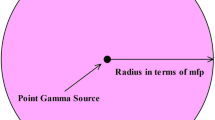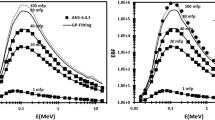Abstract.
In the past, the exposure buildup factors have been calculated with simple physics (free-electron Compton scattering, no coherent scattering, and only K X-ray) such as ANS-6.4.3, etc.. However, in this paper, we calculated the exposure buildup factors for cobalt-60 gamma source with detailed physics (bound-electron Compton scattering, coherent scattering, bremsstrahlung photons and K and L X-rays, pair production) using the MCNPX code. We also showed that there is a significant difference between simple physics and detailed physics for calculating the exposure buildup factors for high atomic number elements. In this work, we used the MCPNX code to perform Monte Carlo simulations as this methodology can provide a better description of the complex chain of microscopic processes involved in the whole volume of material. Therefore, considering the various applications of cobalt-60 both in the industry and in medicine, calculating the exposure buildup factors with detailed physics is very important. In this work, we calculated the exposure buildup factors of cobalt-60 gamma source up to depths of 20 mean free path (mfp) of water, iron and lead with detailed physics through Monte Carlo method by the MCNPX 2.6 code (with particle splitting as an appropriate variance reduction technique). To validate the results, we calculated the exposure buildup factors (with simple physics and detailed physics by the MCNPX code) for a 1 MeV monoenergetic gamma source up to depths of 20 mfp of water, iron and lead and our results showed a good agreement with the literature. Our paper shows that the MCNPX code can be used to calculate the exposure buildup factors of monoenergetic and multi-energy gamma sources with simple physics and detailed physics and to provide an estimate of the difference in the factors between choosing the former or the latter.
Similar content being viewed by others
References
N. Tsoulfanidis, S. Landsberger, Measurement and Detection of Radiation, 4th edition (CRC Press, 2015)
A.B. Chilton, J.K. Shultis, R.E. Faw, Principles of Radiation Shielding (Prentice Hall, london, 1984)
H. Cember, T.E. Johnson, Introduction to Health Physics, 4th edition (McGraw-Hill, New York, 2009)
H. Goldstien, J.E. Wikins, Calculations of the Penetration of Gamma Rays: Final Report, (Nuclear Development Associates, White Plains, NY, 1954)
ANSI/ANS-6.4.3, Gamma-Ray Attenuation Coefficients And Buildup Factors for Engineering Materials, (American Nuclear Society, La Grange Park, IL, 1991)
A. Shimizu, J. Nucl. Sci. Technol. 39, 477 (2002)
A. Shimizu, H. Hirayama, J. Nucl. Sci. Technol. 40, 192 (2003)
A. Shimizu, T. Onda, Y. Sakamoto, J. Nucl. Sci. Technol. 41, 413 (2004)
D. Sardari, S. Saudi, M. Tajik, Ann. Nucl. Energy 38, 628 (2011)
H. Hirayama, J. Nucl. Sci. Technol. 32, 1201 (1995)
M. Kurudirek, Radiat. Environ. Biophys. 53, 175 (2014)
E. Kavas, U. Perisanoglu, N. Ekinci, Y. Ozdemir, Int. J. Radiat. Biol. 92, 380 (2016)
K. Ponnunni Kartha, G.N. Kennedy, J.R. Cameron, Am. J. Roentgenol. 96, 66 (1966)
M.L. Meisberger, R.J. Keller, R.J. Shalek, Radiology 90, 953 (1968)
Y. Harima, Radiat. Phys. Chem. 41, 631 (1993)
H. Atak, O. Sahin Çelikten, M. Tombakoğlu, Appl. Radiat. Isot. 105, 11 (2015)
O. Chibani, Nucl. Sci. Eng. 137, 215 (2001)
X-5 Monte Carlo Team, MCNP- A General Monte Carlo N-Particle Transport Code Version 5, Volume I: Overview and Theory (Los Alamos National Laboratory, 2003)
D.B. Pelowitz, MCNPX User’s Manual Report LA-CP-07-1473, (Los Alamos National Laboratory, 2008)
M.M. Rafiei, H. Tavakoli-Anbaran, J. Instrum. 13, 5008 (2018)
M.M. Rafiei, H. Tavakoli-Anbaran, J. Radiol. Prot. 38, 207 (2018)
J.R. Lamarsh, A.J. Baratta, Introduction to Nuclear Engineering, 3rd edition (Prentice Hall, New Jersey, 2001)
XCOM, National Institute of Standards and Technology, https://doi.org/physics.nist.gov/PhysRefData/Xcom/html/xcom1.html
J.H. Hubbell, Photon Cross Section, Attenuation Coefficients, And Energy Absorption Coefficients from 10 keV to 100 GeV, in NSRDS-NBS, Vol. 29, no. C (1969)
M.M. Bé, V. Chisté, C. Dulieu, E. Browne, C. Baglin, V. Chechev, N. Kuzmenco, R. Helmer, F. Kondev, D. MacMahon, K.B. Lee, Table of Radionuclides (Vol. 3 -- A = 3 to 244) (Editions Bureau International des Poids et Mesures, France, 2006)
Author information
Authors and Affiliations
Corresponding author
Rights and permissions
About this article
Cite this article
Rafiei, M.M., Tavakoli-Anbaran, H. Study of exposure buildup factors with detailed physics for cobalt-60 gamma source in water, iron, and lead using the MCNPX code. Eur. Phys. J. Plus 133, 548 (2018). https://doi.org/10.1140/epjp/i2018-12355-8
Received:
Accepted:
Published:
DOI: https://doi.org/10.1140/epjp/i2018-12355-8




